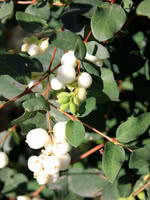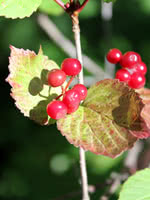Mon-Fri 9am - 5pm Mountain time
Common Snowberry vs Lowbush Cranberry
Symphoricarpos albus
Viburnum edule
NOT AVAILABLE THIS SEASON - MIGHT RETURN
Common Snowberry is a small deciduous shrub with characteristic white to pink flowers and clusters of white fruit.
This North American native species is very adaptable, and can be used for erosion control in riparian and restoration areas. Snowberry's fruit attracts wildlife, and livestock can consume the berries without issue.
Lowbush Cranberry is a short, deciduous shrub native to North America. Its white flowers bear sour but edible fruit that ripens to a brilliant red in fall. Lowbush Cranberry's small size makes it suitable for urban use; buyers will also find it useful if trying to reclaim land back to its original species or when landscaping with native species in damp conditions.
Common Snowberry Quick Facts
Lowbush Cranberry Quick Facts
Toxicity: berries toxic to humans

